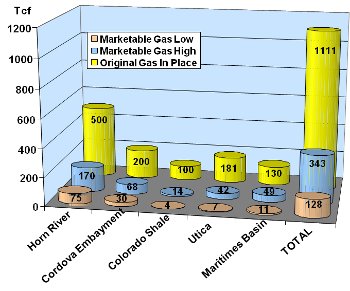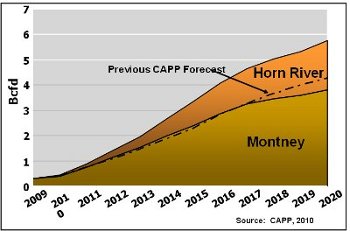
Canada already ranks as one of the world’s top producers and exporters of energy, and its growing unconventional resource base is further buttressing that enviable position.
Canada holds some 4,000 trillion cubic feet (Tcf) of in-place natural gas resources in shales, coal seams, tight sands and conventional reservoirs, said Mike Dawson, president of the Canadian Society for Unconventional Gas, in a luncheon speech at the IHS Inc.-sponsored 2011 International Forum at Winter NAPE in Houston.
"Of our total gas resources, three-fourths lie in unconventional coalbed methane, tight gas and shale reservoirs," Dawson said.
Canada’s heftiest shale-gas deposit lies in the remote, harsh-environment Horn River Basin in northeastern British Columbia. Along with shales in the neighboring Cordova Embayment, the Horn River reservoirs contain 700 Tcf of gas in place, nearly two-thirds of all the shale resources in the True North.
The Muskwa, Klua and Evie shales that comprise the Horn River reservoirs extend across 4,000 square miles. As compared to their U.S. cousins, Horn River shales are slightly deeper and more highly pressured, and their porosities and percentages of total organic carbon are lower. What sets the Horn River shales apart are their remarkable thickness—80 meters—and brittleness. These are ultra-thick shales born to be fractured, it seems.

"The Horn River play is on the verge of development," said Dawson. "We think the basin has the potential to produce as much as 2 Bcf per day by 2020."
Of course, economics are the hurdle, and the pace of development will depend on market prices. Currently, companies are focusing on lowering capital costs and improving well performances. Pad drilling, longer laterals and more frac stages per lateral are all helping operators achieve dramatic cost reductions. Dawson noted that Encana Corp. had decreased its cost per frac stage so significantly that its finding and development costs dropped from C$6.78 per thousand cubic feet in 2007 to C$0.74 in 2010.
The Montney, located south and east of the Horn River area, is Canada’s other major unconventional play. Montney lithologies range from shale to silt to tight sand, and the reservoir transitions from dry gas to liquids. The shale slice of the play is constrained to some 40 townships in British Columbia, while the tight-sand portion covers 475 townships and extends into Alberta.

- Only a small portion of the geographical extent of basin has been explored to date.
- Potential to supply Canada with over 2 Bcf/day by 2020
- Pace of development will be dependent on market conditions
Of Canada’s 1,311 Tcf of in-place tight-gas resource, the Montney holds 550 Tcf.
During the past decade, 512 wells drilled have been drilled for Montney in British Columbia, and 375 of those are currently producing. Current daily production is around 470 million cubic feet.
"The Montney play is competitive at $4 gas," said Dawson. "And we think it has the potential to produce as much as 4 Bcf per day."
Unlike the dry-gas Horn River, the economic viability of the Montney is boosted by a liquids-rich phase. As we see today in the U.S., Canada’s Montney operators are shifting activity to the liquids-rich window in the reservoir, on the updip side of the trend. Wells there can yield as much as 25 to 30 barrels of natural gas liquids per million cubic feet of daily production.

- 512 wells drilled for Montney in British Columbia over the last 10 years of which 375 currently producing
- Cumulative production has totaled 333 Bcf
- Current production approximately 472 Mmcf/d
And, sooner or later, it will flow south. "Currently, Canadian producers are achieving significant cost reductions to maintain economic production," said Dawson. "The efficiencies gained now will enable Canada to maintain a competitive position in the North American market when gas prices stabilize."
Recommended Reading
What Chevron’s Anchor Breakthrough Means for the GoM’s Future
2024-12-04 - WoodMac weighs in on the Gulf of Mexico Anchor project’s 20k production outlook made possible by Chevron’s ‘breakthrough’ technology.
More Oil, Gas Exploration Needed Now—WoodMac
2024-11-25 - New discoveries can reduce costs and emissions intensity while delivering value for resource holders and explorers, Wood Mackenzie analysts said.
E&P Highlights: Jan. 6, 2025
2025-01-06 - Here’s a roundup of the latest E&P headlines, including company resignations and promotions and the acquisition of an oilfield service and supply company.
E&P Highlights: Dec. 9, 2024
2024-12-09 - Here’s a roundup of the latest E&P headlines, including a major gas discovery in Colombia and the creation of a new independent E&P.
Formentera Joins EOG in Wildcatting South Texas’ Oily Pearsall Pay
2025-01-22 - Known in the past as a “heartbreak shale,” Formentera Partners is counting on bigger completions and longer laterals to crack the Pearsall code, Managing Partner Bryan Sheffield said. EOG Resources is also exploring the shale.
Comments
Add new comment
This conversation is moderated according to Hart Energy community rules. Please read the rules before joining the discussion. If you’re experiencing any technical problems, please contact our customer care team.





